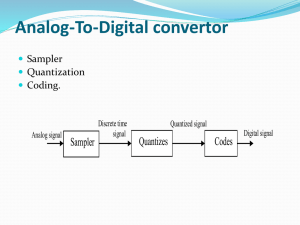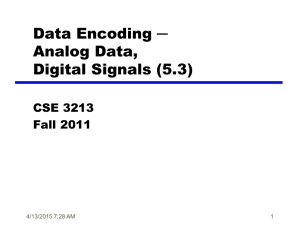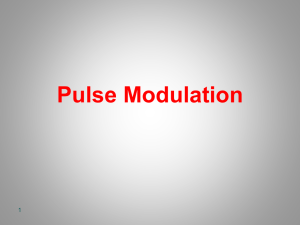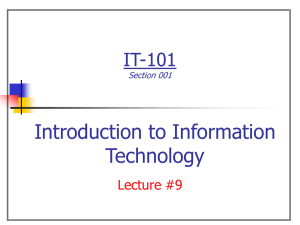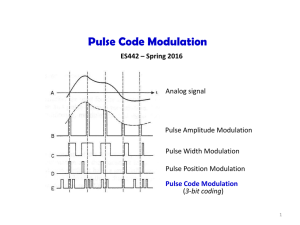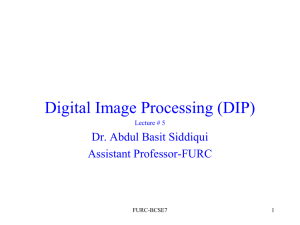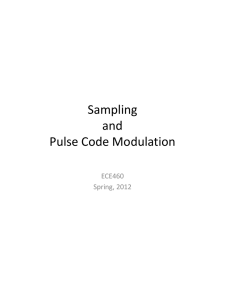Pulse Code Modulation
advertisement
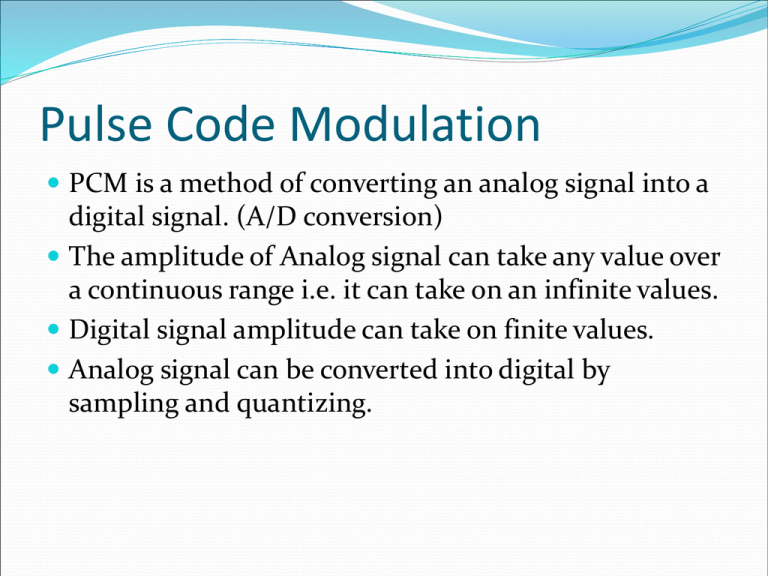
Pulse Code Modulation PCM is a method of converting an analog signal into a digital signal. (A/D conversion) The amplitude of Analog signal can take any value over a continuous range i.e. it can take on an infinite values. Digital signal amplitude can take on finite values. Analog signal can be converted into digital by sampling and quantizing. Cont. Cont. The amplitude of analog signal m(t) lie in the range (-mp, mp) and is partitioned into L sub-intervals each of magnitude 2mp/L Binary pulse codes Quantizing Digital signals come from variety of sources e.g. computer Some sources are analog but are converted into digital form by variety of techniques such as PCM and DM For quantizing , we limit the amplitude of m(t) to a range(-mp, mp) as shown in the previous slides This amplitude is uniformly divided into L subintervals and each interval is , Cont. A sample value is approximated by the mid point of the interval The quantized samples are coded and transmitted as binary pulses At the receiver some pulses will be detected incorrectly There are two types of errors Quantization error Pulse detection error Cont. In almost all practical schemes, the pulse detection error is very small compared to the quantization error and can be ignored Now we analyze the quantization error Cont. Cont. Cont. The integral of the cross product terms is zero and we obtain, Because the sampling rate is 2B, hence the total number of samples over the averaging interval is 2BT This is called the mean of the quantization error Cont. The quantized levels are separated by 2mp/L Since sample value is approximated by the midpoint of the subinterval in which the sample falls The maximum quantization error is The mean square quantizing error is Cont. Cont. Non-uniform quantization SNR is an indication of the quality of the received signal Ideally we would like to have constant SNR Unfortunately, the SNR is directly proportional to the signal power, which varies from talker to talker The signal power can also vary because of the connecting circuits SNR vary even for the same talker, when the person speaks softly Smaller amplitudes pre-dominate in speech and larger amplitude much less frequent. This means the SNR will be low most of the time Cont. The root of this difficulty is that the quantization steps are of uniform value The quantization noise is directly proportional to the square of the step size. The problem can be solved by using smaller steps for smaller amplitudes as shown in fig. on the next slide Cont. Cont. The same result can be obtained by first compressing a signal and then using uniform quantization The input-output characteristics of compressor are shown in fig. Cont. The horizontal axis is normalized input signal and the vertical axis is the output signal y. The compressor maps the input signal into larger increments Hence the interval delta(m) contains large number of steps when m is small The quantization noise is small for smaller input signal Thus loud talker and stronger signals are penalized with higher noise steps in order to compensate the soft talker and weak signals Compression Laws There are two laws regarding compressions (1) This law is used in North America and Japan (2) A-Law This law is used in Europe and the rest of the word Cont. The compressed samples are restored to their original values at receiver by using an expander The compressor and expander together are called compandor. Compression of a signal increases its bandwidth but in PCM, we are not compressing the signal but its samples the number of samples does not change, therefore bandwidth does not rise When meu-law compandor is used then output SNR is Transmission BW and output SNR For binary PCM, we assign distinct group of n binary digits to each of the L quantization levels Each quantized level is encoded into n-bits Minimum channel BW is This is the theoretical minimum transmission bandwidth required to transmit the PCM signal Example 6.2 A signal m(t) band-limited to 3kHz is sampled at a rate 33.33% higher than Nyquist rate, a maximum acceptable error in the sample amplitude is 0.5% of the peak amplitude. The quantized samples are binary coded. Find the minimum channel BW required to transmit the coded signal. If 24 such channels are time-division multiplexed, determine the minimum transmission BW required to transmit the multiplexed signal Solution Exponential Increase of output SNR SNR in decibel scale Cont. Example 6.3 Comments on Logarithmic Units Very small and very large values are expressed in logarithmic units T1 carrier system A schematic of T1-system is shown in fig. Cont. Cont. Differential Pulse Code Modulation Taylor's series Cont. Analysis of DPCM Cont. Delta Modulation Cont. Cont. Delta Modulator Delta Demodulator Delta Modulator output Working of DM
